Chih-Cheng Hung
crossMoDA Challenge: Evolution of Cross-Modality Domain Adaptation Techniques for Vestibular Schwannoma and Cochlea Segmentation from 2021 to 2023
Jun 13, 2025Abstract:The cross-Modality Domain Adaptation (crossMoDA) challenge series, initiated in 2021 in conjunction with the International Conference on Medical Image Computing and Computer Assisted Intervention (MICCAI), focuses on unsupervised cross-modality segmentation, learning from contrast-enhanced T1 (ceT1) and transferring to T2 MRI. The task is an extreme example of domain shift chosen to serve as a meaningful and illustrative benchmark. From a clinical application perspective, it aims to automate Vestibular Schwannoma (VS) and cochlea segmentation on T2 scans for more cost-effective VS management. Over time, the challenge objectives have evolved to enhance its clinical relevance. The challenge evolved from using single-institutional data and basic segmentation in 2021 to incorporating multi-institutional data and Koos grading in 2022, and by 2023, it included heterogeneous routine data and sub-segmentation of intra- and extra-meatal tumour components. In this work, we report the findings of the 2022 and 2023 editions and perform a retrospective analysis of the challenge progression over the years. The observations from the successive challenge contributions indicate that the number of outliers decreases with an expanding dataset. This is notable since the diversity of scanning protocols of the datasets concurrently increased. The winning approach of the 2023 edition reduced the number of outliers on the 2021 and 2022 testing data, demonstrating how increased data heterogeneity can enhance segmentation performance even on homogeneous data. However, the cochlea Dice score declined in 2023, likely due to the added complexity from tumour sub-annotations affecting overall segmentation performance. While progress is still needed for clinically acceptable VS segmentation, the plateauing performance suggests that a more challenging cross-modal task may better serve future benchmarking.
Explicit Change Relation Learning for Change Detection in VHR Remote Sensing Images
Nov 14, 2023



Abstract:Change detection has always been a concerned task in the interpretation of remote sensing images. It is essentially a unique binary classification task with two inputs, and there is a change relationship between these two inputs. At present, the mining of change relationship features is usually implicit in the network architectures that contain single-branch or two-branch encoders. However, due to the lack of artificial prior design for change relationship features, these networks cannot learn enough change semantic information and lose more accurate change detection performance. So we propose a network architecture NAME for the explicit mining of change relation features. In our opinion, the change features of change detection should be divided into pre-changed image features, post-changed image features and change relation features. In order to fully mine these three kinds of change features, we propose the triple branch network combining the transformer and convolutional neural network (CNN) to extract and fuse these change features from two perspectives of global information and local information, respectively. In addition, we design the continuous change relation (CCR) branch to further obtain the continuous and detail change relation features to improve the change discrimination capability of the model. The experimental results show that our network performs better, in terms of F1, IoU, and OA, than those of the existing advanced networks for change detection on four public very high-resolution (VHR) remote sensing datasets. Our source code is available at https://github.com/DalongZ/NAME.
An Unpaired Cross-modality Segmentation Framework Using Data Augmentation and Hybrid Convolutional Networks for Segmenting Vestibular Schwannoma and Cochlea
Nov 28, 2022Abstract:The crossMoDA challenge aims to automatically segment the vestibular schwannoma (VS) tumor and cochlea regions of unlabeled high-resolution T2 scans by leveraging labeled contrast-enhanced T1 scans. The 2022 edition extends the segmentation task by including multi-institutional scans. In this work, we proposed an unpaired cross-modality segmentation framework using data augmentation and hybrid convolutional networks. Considering heterogeneous distributions and various image sizes for multi-institutional scans, we apply the min-max normalization for scaling the intensities of all scans between -1 and 1, and use the voxel size resampling and center cropping to obtain fixed-size sub-volumes for training. We adopt two data augmentation methods for effectively learning the semantic information and generating realistic target domain scans: generative and online data augmentation. For generative data augmentation, we use CUT and CycleGAN to generate two groups of realistic T2 volumes with different details and appearances for supervised segmentation training. For online data augmentation, we design a random tumor signal reducing method for simulating the heterogeneity of VS tumor signals. Furthermore, we utilize an advanced hybrid convolutional network with multi-dimensional convolutions to adaptively learn sparse inter-slice information and dense intra-slice information for accurate volumetric segmentation of VS tumor and cochlea regions in anisotropic scans. On the crossMoDA2022 validation dataset, our method produces promising results and achieves the mean DSC values of 72.47% and 76.48% and ASSD values of 3.42 mm and 0.53 mm for VS tumor and cochlea regions, respectively.
Dual-branch residual network for lung nodule segmentation
May 21, 2019
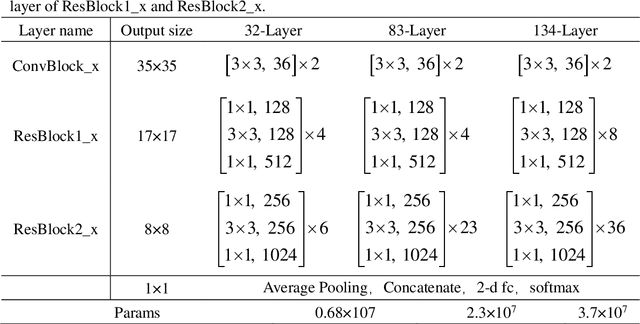
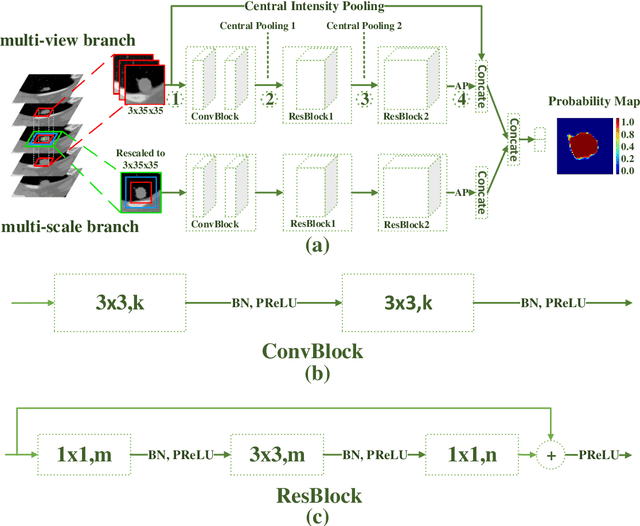
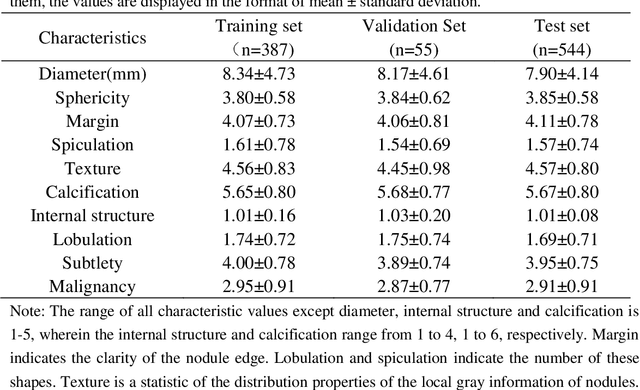
Abstract:An accurate segmentation of lung nodules in computed tomography (CT) images is critical to lung cancer analysis and diagnosis. However, due to the variety of lung nodules and the similarity of visual characteristics between nodules and their surroundings, a robust segmentation of nodules becomes a challenging problem. In this study, we propose the Dual-branch Residual Network (DB-ResNet) which is a data-driven model. Our approach integrates two new schemes to improve the generalization capability of the model: 1) the proposed model can simultaneously capture multi-view and multi-scale features of different nodules in CT images; 2) we combine the features of the intensity and the convolution neural networks (CNN). We propose a pooling method, called the central intensity-pooling layer (CIP), to extract the intensity features of the center voxel of the block, and then use the CNN to obtain the convolutional features of the center voxel of the block. In addition, we designed a weighted sampling strategy based on the boundary of nodules for the selection of those voxels using the weighting score, to increase the accuracy of the model. The proposed method has been extensively evaluated on the LIDC dataset containing 986 nodules. Experimental results show that the DB-ResNet achieves superior segmentation performance with an average dice score of 82.74% on the dataset. Moreover, we compared our results with those of four radiologists on the same dataset. The comparison showed that our average dice score was 0.49% higher than that of human experts. This proves that our proposed method is as good as the experienced radiologist.
Two-Stage Convolutional Neural Network Architecture for Lung Nodule Detection
May 09, 2019
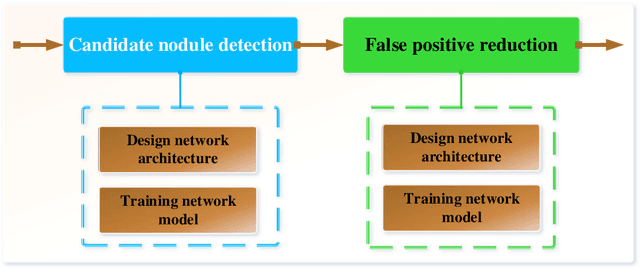

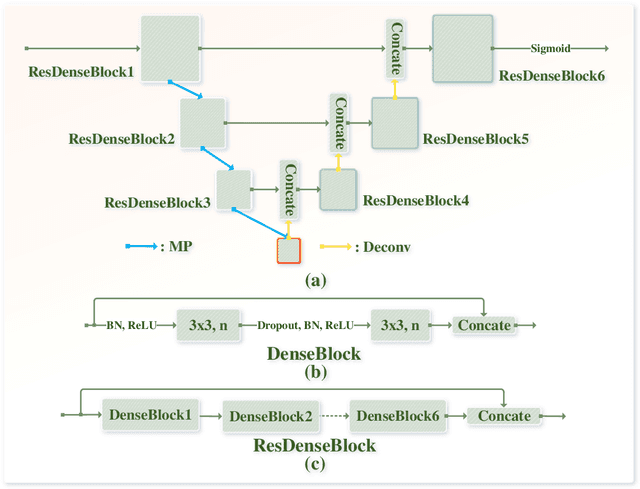
Abstract:Early detection of lung cancer is an effective way to improve the survival rate of patients. It is a critical step to have accurate detection of lung nodules in computed tomography (CT) images for the diagnosis of lung cancer. However, due to the heterogeneity of the lung nodules and the complexity of the surrounding environment, robust nodule detection has been a challenging task. In this study, we propose a two-stage convolutional neural network (TSCNN) architecture for lung nodule detection. The CNN architecture in the first stage is based on the improved UNet segmentation network to establish an initial detection of lung nodules. Simultaneously, in order to obtain a high recall rate without introducing excessive false positive nodules, we propose a novel sampling strategy, and use the offline hard mining idea for training and prediction according to the proposed cascaded prediction method. The CNN architecture in the second stage is based on the proposed dual pooling structure, which is built into three 3D CNN classification networks for false positive reduction. Since the network training requires a significant amount of training data, we adopt a data augmentation method based on random mask. Furthermore, we have improved the generalization ability of the false positive reduction model by means of ensemble learning. The proposed method has been experimentally verified on the LUNA dataset. Experimental results show that the proposed TSCNN architecture can obtain competitive detection performance.
 Add to Chrome
Add to Chrome Add to Firefox
Add to Firefox Add to Edge
Add to Edge